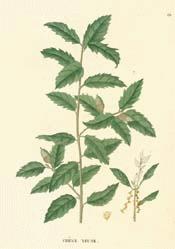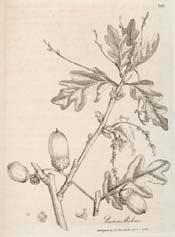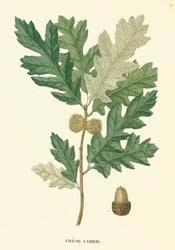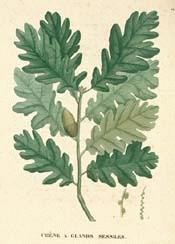
Botanical.com Home Page
Oak, CommonBotanical: Quercus robur
---Synonym---Tanner's Bark.
|

|
(Quercus ilex LINN.) Click on graphic for larger image |
The genus Quercus comprises numerous species, distributed widely over the Northern Hemisphere, and found also in Java, and the Mountains of Mexico and South America. One species from Guatemala, Quercus Skinneri, is remarkable for its resemblance to the Walnut (Juglans) in its lobed and wrinkled seed-leaves or cotyledons.
The Oak is subject to a good deal of variation; many species have been defined and many oaks of foreign origin are grown in our parks, the longest established being the Evergreen or Holm Oak (Q. ilex). There are two principal varieties of Q. robur, often regarded as separate species: Q. pedunculata, the Common Oak, which is distinguished by having acorns in ones and twos attached to the twigs by long stems, the leaves having scarcely any stalk at all; and Q. sessiliflora, the Durmast Oak, often included with the former, but distinct, the leaves being borne on long stalks, while the acorns 'sit' on the bough. This variety of oak is more generally found in the lower parts of Britain and in North Wales. It is not so long-lived as the Common Oak, and the wood, which has a straighter fibre and a finer grain, is generally thought less tough and less resisting.
Q. pedunculata and Q. sessiliflora make good timber, the latter being darker, heavier and more elastic. The wood of these trees when stained green by the growth of a peculiar fungus known as Peziza oeriginosa is much valued by cabinet-makers.
[Top]
---Description---The shape of the oak leaves is too familiar to need description. The flowers are of two kinds; the male, or barren, in long drooping catkins, 1 to 3 inches long, appearing with the leaves, and the leaves and the fertile flowers in distant clusters, each with a cup-shaped, scaly involucre, producing, as fruit, an acorn 1/2 to 1 inch long.
The Oak is noted for the slowness of its growth, as well as for the large size to which it attains. In eighty years the trunk is said not to exceed 20 inches in diameter, but old trees reach a great girth. The famous Fairlop Oak in Hainault Forest measured 36 feet in girth, the spreading boughs extending above 300 feet in circumference. The Newland Oak in Gloucestershire measures 46 feet 4 inches at 1 foot from the ground, and is one of the largest and oldest in the kingdom, these measurements being exceeded, however, by those of the Courthorpe Oak in Yorkshire, which Hooker reports as attaining the extraordinary girth of 70 feet. King Arthur's Round Table was made from a single slice of oak, cut from an enormous bole, and is still shown at Winchester.

|
(Quercus Robur) Click on graphic for larger image |
The famous Oak of Mamre, Abram's Oak, was illustrated formerly in the Transactions of the Linnean Society, by Dr. Hooker. It is a fine specimen of the species Q. Coccifera, the prickly evergreen or Kermes Oak, a native of the countries bordering on the Mediterranean; the insect (coccus) from which it derives its name yielding the dye known as 'Turkey red.' Abram's Oak is 22 feet in circumference; it is popularly supposed to represent the spot where the tree grew under which Abraham pitched his tent. There is a superstition that any person who cuts or maims this oak will lose his firstborn son.
The oak of Libbeiya in the Lebanon measures 37 feet in girth, and its branches cover an area whose circumference measured over 90 yards. The Arab name is Sindian.
The Greeks held the Oak sacred, the Romans dedicated it to Jupiter, and the Druids venerated it.
In England the name Gospel Oak is still retained in many counties, relating to the time when Psalms and Gospel truths were uttered beneath their shade. They were notable objects as resting-places in the 'beating of the parish bounds,' a practice supposed to have been derived from the feast to the god Terminus.
- The following is a quotation from Withers:
- 'That every man might keep his own possessions,
- Our fathers used, in reverent processions,
- With zealous prayers, and with praiseful cheere,
- To walk their parish limits once a year;
- And well-known marks (which sacrilegious hands
- Now cut or breake) so bordered out their lands,
- That every one distinctly knew his owne,
- And brawles now rife were then unknowne.'
- Our fathers used, in reverent processions,
- The ceremony was performed by the clergyman and his parishioners going the boundaries of the parish and choosing the most remarkable sites (oak-trees being specially selected) to read passages from the Gospels, and ask blessings for the people.
- 'Dearest, bury me
- Under that holy oke, or Gospel Tree;
- Where, though thou see'st not, thou may'st think upon
- Me, when you yearly go'st Procession.'
- -----HERRICK
- Under that holy oke, or Gospel Tree;
- An old proverb relating to the oak is still a form of speculation on the weather in many country districts.
- 'If the Oak's before the Ash,
- Then you'll only get a splash;
- If the Ash before the Oak,
- Then you may expect a soak.'
- Then you'll only get a splash;
A curious custom in connexion with wearing an oak-leaf (or preferably an oak-apple) on May 29, still exists in some villages in South Wilts. Each one has the right to collect fallen branches in a certain large wood in the district. To claim this privilege each villager has to bring them home shouting 'Grovely, Grovely, and all Grovely!' (this being the name of the large wood).
After the Oak has passed its century, it increases by less than an inch a year, but the wood matured in this leisurely fashion is practically indestructible. Edward the Confessor's shrine in Westminster Abbey is of oak that has outlasted the changes of 800 years. Logs have been dug from peat bogs, in good preservation and fit for rough building purposes, that were submerged a thousand years ago. In the Severn, breakwaters are still used as casual landing-places, where piles of oak are said to have been driven by the Romans.
As timber, the particular and most valued qualities of the Oak are hardness and toughness; Box and Ebony are harder, Yew and Ash are tougher than Oak, but no timber is possessed of both these requisites in so great a degree as the British Oak. Its elasticity and strength made it particularly advantageous in shipbuilding, and the oaks of the Forest of Dean provided much material for the 'wooden walls of England.' We read that Philip of Spain gave special orders to the Armada to burn and destroy every oak in that forest, and a century later, during a period of twenty-five years, nearly 17,000 loads of oak timber, of the value of L. 30,000 (pounds sterling), were despatched to naval dockyards from this forest. Nelson drew up a special memorial to the Crown on the desirability of replanting this forest with oak trees, and at that time no forester dared to cut down a crooked tree before maturity, because its knees and twisted elbows were so desirable in shipbuilding. A tree should be winter felled, if perfection of grain is desired. Although not employed as of old, for building ships of war, it is in great request for peaceful land transit, sharing with Ash in the making of railway carriages and other rolling stock. The roots were formerly used to make hafts for daggers and knives.

|
(Quercus cerris LINN.) Click on graphic for larger image |
The False Sandalwood of Crete is the produce of Q. abelicea. This wood is of a reddish colour, and has an agreeable perfume. The less valuable oaks furnish excellent charcoal and firewood.
The bark is universally used to tan leather, and for this purpose strips easily in April and May. An infusion of it, with a small quantity of copperas, yields a dye which was formerly used in the country to dye woollen of a purplish colour, which, though not very bright, was said to be durable. The Scotch Highlanders used it to dye their yarn. Oak sawdust used also to be the principal indigenous vegetable used in dyeing fustian, and may also be used for tanning, but is much inferior to the bark for that purpose. Oak apples have also been occasionally used in dyeing as a substitute for the imported Oriental galls, but the black obtained from them is not durable.
In Brittany, tan compressed into cakes is used as fuel. Oak-bark is employed for dyeing black, in conjunction with salts of iron. With alum, oak-bark yields a brown dye; with a salt of tin, a yellow colour; with a salt of zinc, Isabelia yellow. Q. tinctoria, a North American species, yields Quercitron Bark, employed for dyeing yellow; the American Indians are said to dye their skins red with the bark of Q. prinus. After the oakbark has been used for leather-tanning, it is still serviceable to gardeners for the-warmth it generates and is largely used by them under the name of Tan; it sometimes, however, favours the growth of certain fungi, which are harmful to plants. Refuse tan is also employed in the adulteration of chicory and coffee.
Acorns were of considerable importance formerly for feeding swine. About the end of the seventh century, special laws were made relating to the feeding of swine in woods, called pawnage, or pannage. In Saxon times of famine, the peasantry were thankful for a share of this nourishing, but somewhat indigestible food. The Board of Agriculture has lately issued a pamphlet, pointing out the use as fodder, which might be made both of the Acorn and of the Horse Chestnut. The analysis of the Acorn given by the Lancet is: water, 6.3 per cent; protein, 5.2 per cent; fat, 43 per cent; carbohydrates, 45 per cent. The most important constituent of both the Acorn and the Horse Chestnut is the carbohydrate in the form of starch, while the Acorn should have further value on account of the substantial proportion of fat which it contains. The flavour of Acorns is improved if they are dried, and a flour with nourishing properties can be obtained by grinding the dried kernels.
In many country districts acorns are still collected in sacks and given to pigs; but these must be mixed with other vegetable food to counteract their binding properties.
Oak trees are more persistently attacked by insects than any other trees.
[Top]
---Medicinal Action and Uses---The astringent effects of the Oak were well known to the Ancients, by whom different parts of the tree were used, but it is the bark which is now employed in medicine. Its action is slightly tonic, strongly astringent and antiseptic. It has a strong astringent bitter taste, and its qualities are extracted both by water and spirit. The odour is slightly aromatic.
Like other astringents, it has been recommended in agues and haemorrhages, and is a good substitute for Quinine in intermittent fever, especially when given with Chamomile flowers.
It is useful in chronic diarrhoea and dysentery, either alone or in conjunction with aromatics. A decoction is made from 1 OZ. of bark in a quart of water, boiled down to a pint and taken in wineglassful doses. Externally, this decoction has been advantageously employed as a gargle in chronic sore throat with relaxed uvula, and also as a fomentation. It is also serviceable as an injection for leucorrhoea, and applied locally to bleeding gums and piles.
[Top]
---Preparation and Dosage---Fluid extract, 1/2 to 1 drachm.
Oak bark when finely powdered and inhaled freely, has proved very beneficial in consumption in its early stages. Working tanners are well known to be particularly exempt from this disease. A remedial snuff is made from the freshly collected oak bark, dried and reduced to a fine powder.
The bark is collected in the spring from young trees, and dried in the sun. It is greyish, more or less polished externally and brownish internally. The fracture is fibrous and the inner surface rough, with projecting medullary rays.
The older herbalists considered the thin skin that covers the acorn effectual in staying spitting of blood, and the powder of the acorn taken in wine was considered a good diuretic. A decoction of acorns and oak bark, made with milk, was considered an antidote to poisonous herbs and medicines.
The distilled water of the oak bud was also thought 'to be good used either inwardly or outwardly to assuage inflammation.'
Galen applied the bruised leaves to heal wounds.
[Top]
Oak Galls
Galls are excrescences produced in plants by the presence of the larvae of different insects. The forms that they assume are many, and the changes produced in the tissues various. They occur in all parts of the plant and sometimes in great quantities.The oak galls used in commerce and medicine are excrescences on the Q. infectoria, a small oak, indigenous to Asia Minor and Persia, and result from the puncture of the bark of the young twigs by the female Gallwasp, Cynips Gallae-tinctoriae, who lays its eggs inside. This species of oak seldom attains the height of 6 feet, the stem being crooked, with the habit of a shrub rather than a tree.
The Common Oaks of this country are much affected by galls. They occur sometimes on the leaves, where they form the socalled 'Oak-apples,' sometimes on the shoots, where they do great mischief by checking and distorting the growth of the tree.
The young larva that hatches from the eggs feeds upon the tissues of the plant and secretes in its mouth a peculiar fluid, which stimulates the cells of the tissues to a rapid division and abnormal development, resulting in the formation of a gall.
The larva thus becomes completely enclosed in a nearly spherical mass, which projects from the twig, furnishing it with a supply of starch and other nutritive material.
The growth of the gall continues only so long as the egg or larva lives or reaches maturity and passes into a chrysalis, from which the fully-developed gall-wasp emerges and escapes into the air through a hole bored with its mandibles in the side of the gall.
The best Aleppo galls, collected in Asiatic Turkey, principally in the province of Aleppo, are collected before the insects escape.
Galls are also largely imported from Persia and to a lesser extent from Greece.
Aleppo Galls of good quality are hard and heavy, without perforations, dark bluish-green or olive green, nearly spherical in shape, 12 to 18 mm. in diameter (about 2/5 to 4/5 inch), and known in commerce as blue or green galls.
The Aleppo galls (from Q. infectoria) sometimes also called 'Mecca Galls,' are supposed to be the Dead Sea or Sodom Apples, 'the fruit that never comes to ripeness' - the fruit so pleasant to the eye, so bitter to the taste.
If collected after the insects have escaped, galls are of a pale, yellowish-brown hue, spongy and lighter in weight, perforated near the centre with a small hole. These are known in commerce as white galls.
On breaking a gall, it appears yellowish or brownish-white within, with a small cavity containing the remains of a larva of the Gall-wasp.
Galls have no marked odour, but an intensely astringent taste, and slightly sweet after-taste.
[Top]
---Constituents---The chief constituents of Aleppo or Turkey Galls are 50 to 70 per cent of gallotannic acid, 2 to 4 per cent of gallic acid, mucilage, sugar, resin and an insoluble matter, chiefly lignin.
'White' galls contain less gallotannic acid than 'blue' or 'green.'
English Oak Galls, or Oak Apples, are smooth, globular, brown, usually perforated and much less astringent than Aleppo Galls, containing only 15 to 20 per cent of gallotannic acid. They have no commercial value.
China Galls - produced by a species of Aphis on Rhus semialata - are used mainly for the manufacture of tannic and gallic acids, pyrogallol, ink, etc. They are not spherical, but of extremely diverse and irregular form, with a thick, grey, velvety down, making them a reddish-brown colour. They contain about 70 per cent of gallotannic acid.
Mecca Galls, from Bassorah, known as 'mala nisana,' are spherical in shape and surrounded about the centre by a circle of horned protuberances. They are not official.
[Top]
---Medicinal Action and Uses---Galls are much used commercially in the preparation of gallic acid and tannic acid, and are extensively employed in tanning and dyeing, in the manufacture of ink, etc.
Medicinally, they are a powerful astringent, the most powerful of all vegetable astringents, used as a tincture internally, in cases of dysentery, diarrhoea, cholera, and as an injection in gonorrhoea, leucorrhoea, etc.
Preparations of gall are usually applied as a local astringent externally, mainly in Gall ointment ( 1 OZ. powdered galls and 4 OZ. benzoated lard), applied to painful haemorrhoids, and also to arrest haemorrhage from the nose and gums.
An infusion may be used also as a gargle in relaxed throat, inflamed tonsils, etc.
---Preparations and Dosages---Powdered gall, 5 to 20 grains. Fluid extract, 5 to 20 drops. Tincture, U.S.P., 1 drachm. Ointment, B.P. Compound ointment, B.P.
[Top]
© Copyright Protected 1995-2025 Botanical.com
